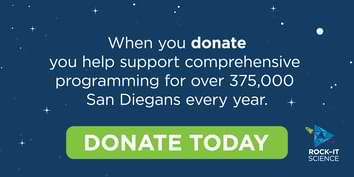
Photo Captions for GREAT BALLS OF FIRE! Comets, Asteroids, Meteors Opens Saturday, January 19, at the REUBEN H. FLEET SCIENCE CENTER!
FOR IMMEDIATE RELEASE, PLEASE:
Media Contact: Susan Chicoine, PR Manager
619-685-5743 / 619-325-9416c schicoine@rhfleet.org
Photos from the GREAT BALLS OF FIRE! Comets, Asteroids, Meteors Exhibition:
Entry_fireball: A fireball making its entry into our atmosphere
Meteors small: Meteors fly through space
Meteorites: Girls examine “Is it Rock or Meteorite?” exhibit
IMG_5760: Examining “Is it Rock or Meteorite?” under the microscope
Kids 08: “What If it hit My Town?”
Mystery Asteroid: Name the “Mystery Asteroid”
IMG_5750: Boys checking out a Great Balls of Fire exhibit
IMG 5903: The challenge of “Can You Save Earth?”
IMG 5855 (crop): In the pod at “Comet & Asteroid Quest”
Hayabusa Mural 2C_1024: Itokawa asteroid pictured in the Hayabusa mural
DI Rawlings: Concept drawing of NASA Deep Impact Mission by Pat Rawlings
502_DAWN_1024: NASA Mission DAWN orbiting Vesta
505_Dinos_1024: Dinosaur extinction event mural
WISE master_2_1024: NASA mission WISE maps the cosmos
Great Balls of Fire logo
Photo Credit: © The Space Science Institute
# # #
DOWNLOADS FOR MEDIA:
Press releases, backgrounders and photo caption sheets: http://www.rhfleet.org/press-room
High-resolution photographs: http://www.rhfleet.org/press-room/images.
B-roll of Giant Dome Theater Shows & production footage of exhibits and galleries: Fleet Media DropBox: https://www.dropbox.com/; sign in; email: reubenfleet@gmail.com; password: pr1973media; "RHF Public Relations."
San Diego, CA; December 13 2012—The new Great Balls of Fire! Comets, Asteroids, Meteors exhibition will make its West Coast debut at the Reuben H. Fleet Science Center on January 19, 2013, and remain through April 28, 2013. The threat of a catastrophic impact from an asteroid or comet is a staple of popular culture. If there was a dinosaur-killer in Earth’s past, will humankind suffer the same fate? What are the chances and how do we assess the risks? For that matter, what are asteroids, comets, and meteorites, and where do they come from?
Great Balls of Fire! Comets, Asteroids, Meteors explores recent discoveries and cutting-edge science relating to these incredible objects. Have you ever wondered about the origins of comets, asteroids and meteors? Or what they can tell us about Earth? Come to the Reuben H. Fleet Science Center to explore these mysterious space rocks through hands-on activities, computer-based interactives, meteorite specimens, scale models and an immersive audio-visual experience called Asteroid Encounter.
The exhibition is divided into four areas: Origins, Asteroids, Comets and Impacts. It includes a variety of interactive, multimedia experiences. Visitors of all ages can take on the role of explorers, participate in real-world amateur astronomy activities and make comparisons between the risks of asteroid or comet impacts and more familiar natural disasters such as tsunamis, tornados, earthquakes and volcanic eruptions. It also relates the stories of individual scientists whose work has furthered the study of asteroids and comets.
While asteroids and comets are popular subjects for movies like Armageddon and Deep Impact, they are playing their own starring roles in NASA research, and ongoing discoveries are a highlight of the exhibition. In 2001, NASA’s NEAR Shoemaker spacecraft dramatically landed on the asteroid Eros. In 2005, NASA’s Deep Impact probe collided with Tempel 1, exploring beneath the comet’s surface. In 2007, NASA launched the Dawn spacecraft to the Main Asteroid Belt, orbiting the asteroid Vesta. Both NASA and numerous amateur astronomers will be closely monitoring the progress of two possible “Great Comets” in 2013, ISON and PANSTARRS.
Great Balls of Fire! Comets, Asteroids, Meteors includes exhibits, an education program, an outreach program to engage amateur astronomers, a public website (http://www.killerasteroids.org/) and a program website (http://www.greatballsoffireexhibit.org/). Developed by The Space Science Institute’s National Center for Interactive Learning, with funding from the National Science Foundation and NASA, this new exhibition debuted on May 28, 2012. The exhibition has only traveled to the Science Museum of Virginia, Strategic Air & Space Museum in Nebraska, and Catawba Science Center in North Carolina. The Reuben H. Fleet Science Center is delighted to host its West Coast landing!
Great Balls of Fire! Comets, Asteroids, Meteors opens January 19, 2013, and remains through April 28, 2013. The Reuben H. Fleet Science Center is located at 1875 El Prado, San Diego, CA 92101. Gallery admission, which includes access to all eight exhibit galleries: Adults $11.75; Children/Seniors $9.75. The Fleet’s hours are Monday–Thursday 10AM–5PM, Friday & Saturday 10AM–7PM, and Sunday 10AM–6PM. For more information, call (619) 238-1233 or visit our website at www.rhfleet.org/site/exhibition/upcomingexhibits.html.
# # #
About The Space Science Institute
The Space Science Institute’s National Center for Interactive Learning is a nonprofit organization that carries out world-class research in space and Earth science, together with innovative science education programs that inspire and deepen the public’s understanding of planet Earth and its place in the Universe. The institute's integrated research and education programs span planetary science, space physics, astrophysics, astrobiology, and Earth science.
# # #